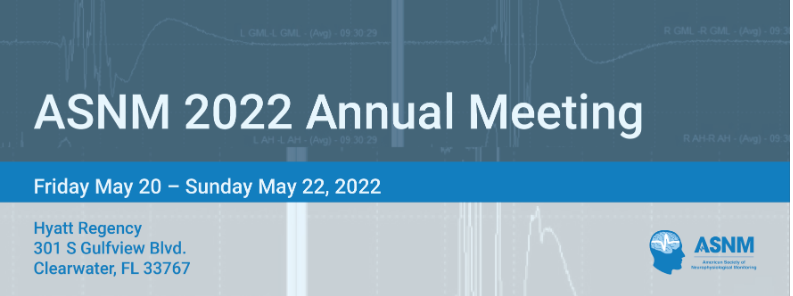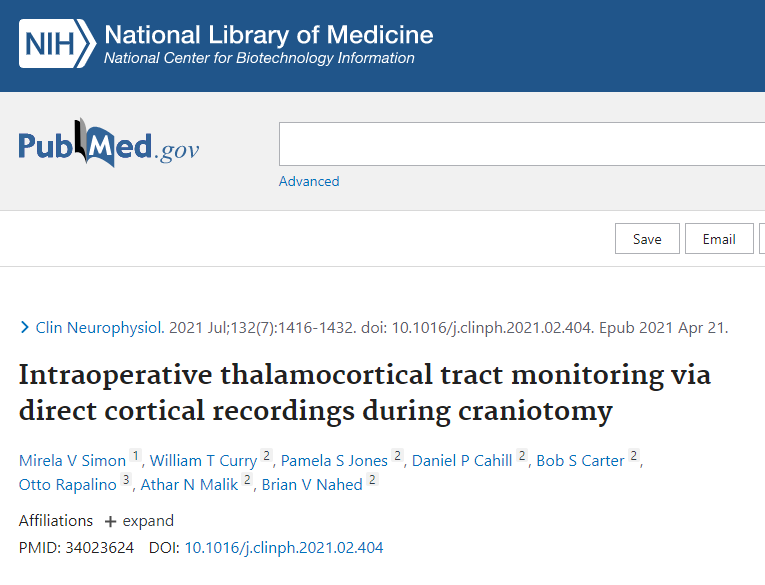Remember a couple of years ago when we would all meet up at IONM conferences to share ideas and network in real life?
Well, I’m venturing off to my first one since COVID-19 hit. This year’s ASNM annual meeting is in Clearwater, Fl on May 20th and I’ll be there looking to pick up a couple of big ideas from the presentations and/or the people I meet.
And as I started going through my own plans for the conference, I decided to jot down my thoughts for those that might find some tips useful.
Plus, as some of you might be finding out, it’s becoming harder and harder to get companies or hospitals to pony up some $ to cover the cost. Travel, lodging, food — it’s all getting expensive. It’s important to be able to demonstrate value in order to justify it to yourself and your company.
How to (Better) Attend a Neuromonitoring Conference
At my first neuromonitoring conference, I treated it like I did when I was in school. T-shirt, shorts, and sandals (that’s how a Florida kid learns best). I was ready to absorb the prepared lectures by sitting and listening.
But my plan missed the larger opportunity. I was thinking transactionally. Like… I paid for this thing = you teach me.
Now information is virtually free. You can learn just about anything with some good online searches. In my opinion, deciding to go to a conference over a webinar MUST require getting more than the information to justify the cost.
But you may not agree with me, especially if you’re coming down from Michigan to Clearwater beach for a weekend. So I broke down the different levels of what you’re looking/willing to do and get the best ROI for that level of effort.
Level 1: The Learner
This is the conference-goer there to listen to the presentations and try to learn something new and/or reinforce what they already understand. This should be the bare minimum you aim for. Anything less is Level 0: The Wast of Timer. They should just save the money.
Here, you’ll want to:
- Pick your top 3 presentations – you should expect to only retain 10% of what you’ll learn there, so make it count. Study those 3 topics before the conference. This will allow you to pick up on the nuances and ask better questions during the session. After looking through the agenda, I saw a technique studied by Dr. Simon that I haven’t done myself. A little Google searching lead me to thalamocortical tract monitoring and I have some preliminary info to start digging deeper.
- Take handwritten notes – the act of writing isn’t just so you have something to reflect on later. It actually increases your ability to remember the material. Do this for all the presentations.
- Repurpose your notes – I already did a post on how to be strategic in your learning process and using tools like Neurcache to help with spaced repetition. You’ll want to add what you’re learning here to your ever-growing repository of neuromonitoring notes and study guides.
- Divide and conquer – since there are 2 rooms going at once, see if you can team up with someone going to the lecture you’re not. Share notes/thoughts.
Level 2: The Educator
It would be great to send an entire team to a conference but the life of a surgical neurophysiologist won’t allow for it.
As a result, there will be some left behind on what’s being presented as the latest and greatest discussion in neuromonitoring. Wouldn’t it make your team/company better if you come back to break down the most important big ideas?
Here’s what you might offer to your company in return for paying your way:
- Team/company meetings – reteach what you learned at the conference to the others on your team. Seeing as there is about 20 hours of content, you might have enough to get through monthly meetings for the entire year. (What, you aren’t having meetings at your company? You should! If you aren’t moving forward, you’re falling behind)
- Teach your surgeons – offer a higher level of service by continuing to improve or expand what you’re doing today. Repurpose what you learned to fit a surgeon’s perspective. This isn’t just about you, your company, and the patients you serve. This is about ensuring the progress of the industry as a whole. Consistent readers of this blog should know we’re hunting stag, not hares.
- Pick up some new surgeons – what company doesn’t like it when their clinicians pick up new business. Rainmakers have a spot at any company. Use your new knowledge to get more neuromonitoring cases.
Level 3: The Networker Experience Maker
While there might be people there that can neglect Level 1 for Level 2 (like a recruiter or someone working a booth), most surgical neurophysiologists should consider Level 2 to be in addition to what’s expected at Level 1.
And really, should you even be going to a conference if you don’t intend on doing some sort of networking?
There are some of you extroverts that really excel in this world. Introverts, like myself, require more energy to accomplish the same thing. Either way, if we’re spending money and expending energy, we should look to optimize outcomes.
The problem with most networking is the same problem with most schoolwork: it’s slightly beneficial but is mostly busywork.
Walking around and introducing yourself, handing out business cards, and even spewing some elevator pitch of sorts feels gross for both people.
And while the extroverts are pretty good at popping in and out of conversations with strangers all day, it’s the introverts that tend to rule the deep one-on-one conversations: the meaningful, memorable ones that actually last beyond the day.
The solution for both is to do your best to turn a networking event into an experience. It doesn’t have to shatter worldviews but your gestures should be different/large enough to ensure the desired reaction depending on what you’re looking to achieve.
To get a game plan, you can nerd out and pick through lessons of neuroplasticity, or look to other professionals that make a living doing what we’re looking to accomplish. Creating experiences is very much part of any good marketer’s daily thoughts.
In that world, they are looking to create peaks, or memorable moments in their customers’ lives, that stay on brand and can be duplicated. Thy not only want the customer to experience delight but they want them to tell others about it. Wouldn’t you want the same for your own personal brand and the company you represent?
An often-used example is Double Tree’s hot chocolate chip cookies given to every customer at the front desk upon check-in. It’s an unexpected treat that stays on-brand (catered-to-comfort) that gets their customers talking behind their backs in a positive light.
It’s a great strategy for developing word-of-mouth marketing and was coined Talk Triggers.

Now, if you just had a eureka moment that you’re going to palm some chocolate chip cookies while shaking hands as an advanced personal brand strategy, I’m going to ask you to think harder. Yes, gimmicks can work. And they can backfire. Wearing a tuxedo to the event will make you stick out, but doesn’t hit all 4 quadrants above (seeing as it does nothing for others). You should come up with your own and apply it to the more general advice below, which is more about approaching your targets.
- Hold higher-level discussions with the presenters – remember the advice in Level 1 to study before the conference? Here’s where it will help you with your networking. This hack allows you to be an opportunistic networker by creating a memorable experience for presenters. Those doing the presenting typically are chosen because they know something valuable and are known by others to know something valuable. They tend to run in influential circles, either on the knowledge side, the business side, or both. These are your easy “high return” networking targets. So decide what you’d like to do. It could be as simple as reaching out beforehand to let them know you’ve circled their presentation on your agenda and can’t wait to hear it, or send a personal note to the speaker on what you learned and planned to do with it. It could be a small gesture from you or your company right after the presentation, keeping within the 4 requirements of a talk trigger.
- Meet and delight your peers – while out there rubbing elbows with others in your field, do you think you could do better than handing them a business card or a pen at a booth? See if you can offer anything to them, like your experience, knowledge, or network. Come prepared with conversation that goes past small talk by asking questions requiring thoughtful responses. Questions like… “What do you know about the neuromonitoring field that (you believe to be true but others disagree with) or (most don’t already know, but soon will) or (is true today, but won’t be tomorrow). Then, of course, you follow up with them with additional information about your conversation.
TalkCommunicate with Vendors – most vendors will not close sales on the day of the conference. It’s more about building awareness. Don’t treat them like you would the person handing you meat on a toothpick at the mall. Hearing their elevator pitch as you scoop up a tote bag is kind of you, but a better gesture is to get into a deep conversation. You may have no purchasing power, but you might have insights as to why your boss may or may not buy. Or you might be able to give a referral to someone that could use their product. Or you might just end up finding something you’d like to buy. Either way, these are people that know people and can be a good resource to have in your circle of peers. If you can’t give them a sale, help them get closer to their next one. Follow up with any promises made.
Conclusion
I’m glad we’re back in a place where we feel comfortable enough for large gatherings. It’s been years since I’ve seen people in SpecialtyCare, let alone the rest of the IONM community. I’m fortunate to work for a company whose target is data-driven growth, which means paying for further education of their staff as part of the ethos.
I didn’t learn my lesson for my first 1-2 conferences, but being a passive guest doesn’t justify the cost (IMO). You need to be active with a game plan, where the execution starts before it starts and lasts long afterward. The knowledge gained is the main course but I suggest you not neglect the opportunity to make connections, build your personal and company brand, learn from the experiences of your peers, and enjoy hanging out with like-minded people in real life.





